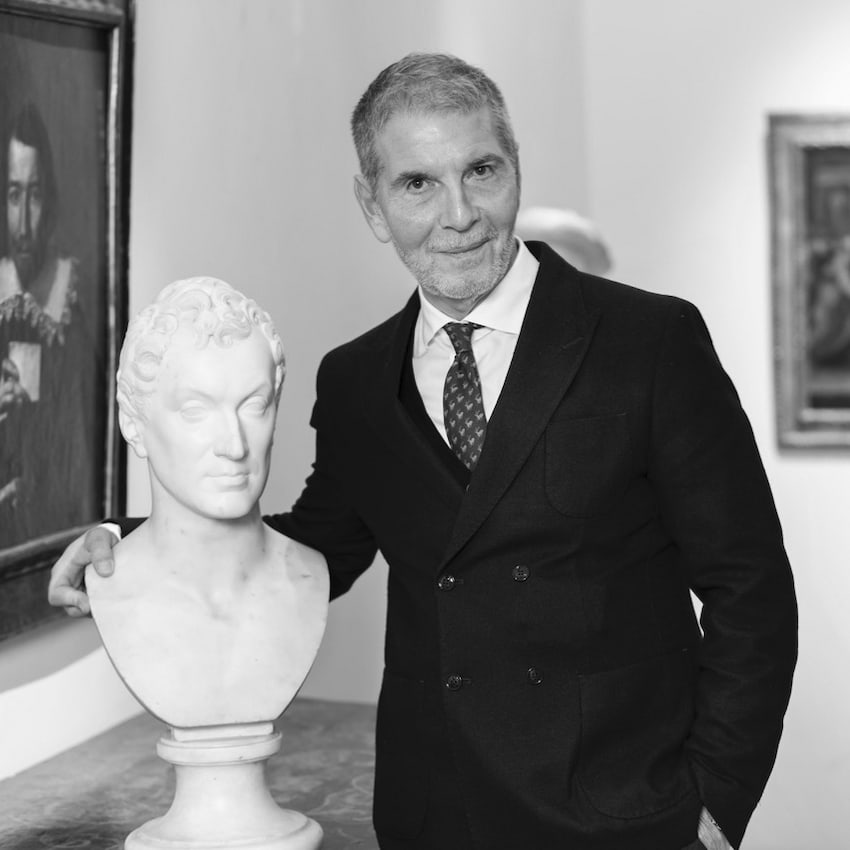ITALY
FRANCE
Directors: Maurizio Nobile, Attilio Luigi Ametta, Davide Trevisani, Stefano Bosi
Directors: Maurizio Nobile, Attilio Luigi Ametta, Davide Trevisani, Stefano Bosi
Palazzo Bovi-Tacconi
Via Santo Stefano, 19/a - 40125 - Bologne (IT)
Palazzo Bagatti-Valsecchi
Via Santo Spirito, 7 - 20121 - Milan (IT)
Hôtel Jean Bart | Claude Passart
2, rue Chapon - 75003 - Paris (FR)
Phone: +33 (0)6 22 54 51 89
E-mail: info@maurizionobile.com

Established in 1987, Maurizio Nobile Gallery has built up a solid reputation in the field of Italian master paintings, drawings, and sculptures from the end of the 15th to the beginning of the 20th century.
On the strength of its international reputation, in 2010 the gallery settled permanently in Paris and, in 2021, in Milan, in the prestigious set of Palazzo Bagatti-Valsecchi.
Over the years, the gallery has become a point of reference for private collectors as well as for prestigious European and international museums.
The gallery also takes part in the most important international art fairs and events.
Sant'Angelo in Vado, 1539- Ancona, 1609
Black chalk, pen, brown ink, red chalk and brown wash
287x350 mm
Inscriptions
Lower left, in pen and brown ink, in old style: MicheleAngelo Buenarotti
Among the drawings we will be displaying at the upcoming edition of the Salon du Dessin there will be a very rare drawing by Federico Zuccari.
It is a study for the north-east section of Hell at the base of the dome of Santa Maria del Fiore in Florence.
Giorgio Vasari had begun the decoration of the dome, but the work was interrupted by his death in June 1574; Federico Zuccari was commissioned to bring it to completion. Zuccari arrived in Florence in October 1575, assembling a large team of collaborators, and remaining there until 1579. The iconographic scheme of the decorative scheme, based on Dante's Divina Commedia, was conceived by the humanist Vincenzo Borghini.
Our drawing shows one of the sections of the last circle of the cupola of Santa Maria del Fiore, depicting the Last Judgement.
We know from a letter written by Federico Zuccari on 30 October 1577 to Sebastiano Caccini, the owner of his Roman residence, that at that time the artist was starting work on the area of Hell organised into seven compartments, each one dedicated to one of the deadly sins.
Our drawing prepares the north-east area of this part of the set, which is entirely due to Federico Zuccari's invention.
It depicts the sin of Envy and the Seven-Headed Hydra. Very few drawings for this group by the master himself have survived.
The style and technique are perfectly coherent with the drawing at the Uffizi, depicting Gli Accidiosi; a drawing that, for the high quality of its execution, is unanimously attributed to Federico Zuccari. A delicate underlying black stone sketch, a delicate pen for the contours of the bodies, and some fine chromatic effects achieved through patches of brown and chalk washes clearly link the two drawings.
The immediacy of some details, and the inventiveness and fluidity of the brushwork, suggest that the artist himself is solely responsible for the creation of our sheet, even if the connection with the damned in the foregoing scene is treated schematically.
Several variations on the definitive work can be detected, such as in the group of the damned ready to topple over. The upturned nude seen in perspective in the foreground announces the engraving with The Fall of Icarus by Hendrik Goltzius, dated 1588, and based on an invention of Cornelsz van Haarlem.
A curious anecdote. What can we learn from the old inscription in the bottom left-hand corner of the sheet, which dates back to the early 17th century at the latest?
First, it tells us that the drawing very quickly found its way onto the market or into a private collection, where it was considered a landmark piece, being attributed to the great Michelangelo Buonarroti, and that its relationship with the decoration of Santa Maria del Fiore was no longer retained.
Lastly, according to the way in which the name of the great Florentine artist is phonetically transcribed, this inscription tells us that our sheet very early belonged to a dealer or a collector of Spanish origin. This is a path to follow to try to retrace the history of this rare drawing by Federico Zuccari.
Dear visitors,
Due to the gravity of the international situation resulting from the spread of COVID-19 and in order to protect the health of all parties concerned, we have decided to cancel the 29th edition of the Salon du dessin.
France officially declared a state of health emergency on 24 March for two months and there are still numerous uncertainties regarding the evolution of the pandemic over the coming months. These factors make it impossible to reprogram the Salon before the summer of 2020 and the Salon du dessin, which usually attracts numerous other events in Paris for a week, will therefore not take place this year.
Louis de Bayser, President of the Salon du dessin said “this is a difficult decision to take with regard to all those who worked hard for this edition, but our priority is to protect the health of all our exhibitors, visitors and partners”.
We send our thoughts to all those affected by this epidemic and hope that this unprecedented health situation will quickly change favorably.
The organizers of the Fair